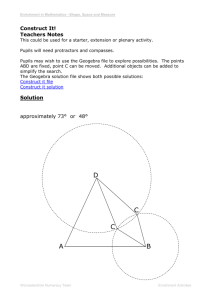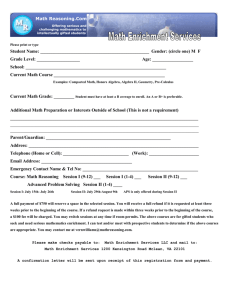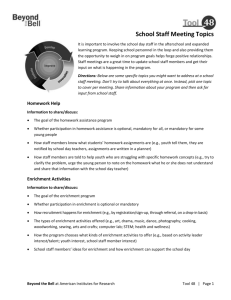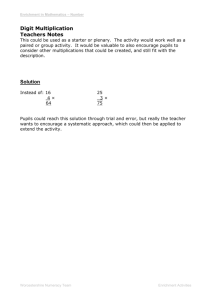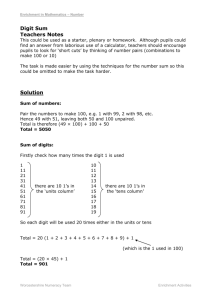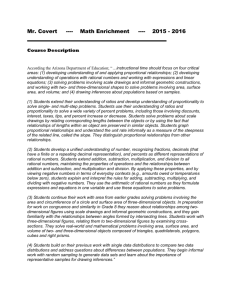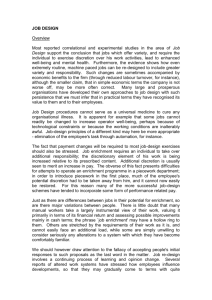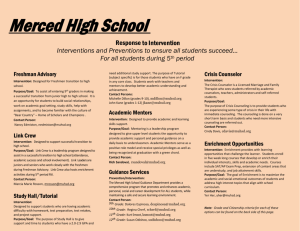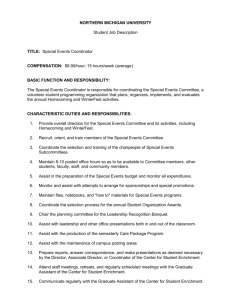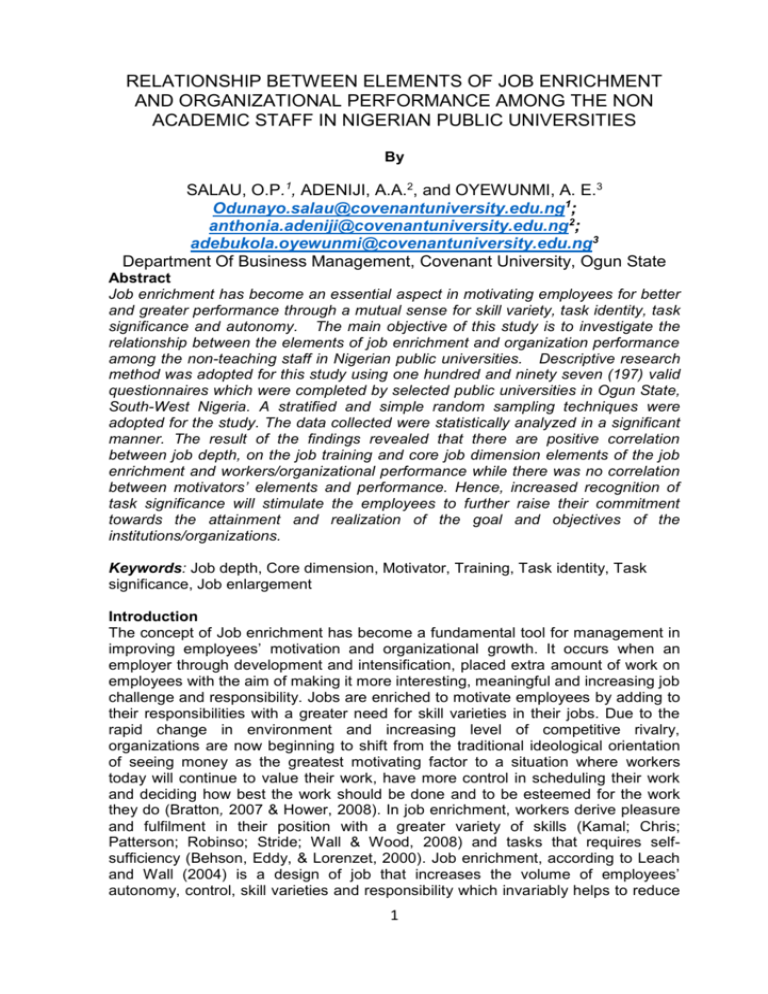
RELATIONSHIP BETWEEN ELEMENTS OF JOB ENRICHMENT
AND ORGANIZATIONAL PERFORMANCE AMONG THE NON
ACADEMIC STAFF IN NIGERIAN PUBLIC UNIVERSITIES
By
SALAU, O.P.1, ADENIJI, A.A.2, and OYEWUNMI, A. E.3
Odunayo.salau@covenantuniversity.edu.ng1;
anthonia.adeniji@covenantuniversity.edu.ng2;
adebukola.oyewunmi@covenantuniversity.edu.ng3
Department Of Business Management, Covenant University, Ogun State
Abstract
Job enrichment has become an essential aspect in motivating employees for better
and greater performance through a mutual sense for skill variety, task identity, task
significance and autonomy. The main objective of this study is to investigate the
relationship between the elements of job enrichment and organization performance
among the non-teaching staff in Nigerian public universities. Descriptive research
method was adopted for this study using one hundred and ninety seven (197) valid
questionnaires which were completed by selected public universities in Ogun State,
South-West Nigeria. A stratified and simple random sampling techniques were
adopted for the study. The data collected were statistically analyzed in a significant
manner. The result of the findings revealed that there are positive correlation
between job depth, on the job training and core job dimension elements of the job
enrichment and workers/organizational performance while there was no correlation
between motivators’ elements and performance. Hence, increased recognition of
task significance will stimulate the employees to further raise their commitment
towards the attainment and realization of the goal and objectives of the
institutions/organizations.
Keywords: Job depth, Core dimension, Motivator, Training, Task identity, Task
significance, Job enlargement
Introduction
The concept of Job enrichment has become a fundamental tool for management in
improving employees’ motivation and organizational growth. It occurs when an
employer through development and intensification, placed extra amount of work on
employees with the aim of making it more interesting, meaningful and increasing job
challenge and responsibility. Jobs are enriched to motivate employees by adding to
their responsibilities with a greater need for skill varieties in their jobs. Due to the
rapid change in environment and increasing level of competitive rivalry,
organizations are now beginning to shift from the traditional ideological orientation
of seeing money as the greatest motivating factor to a situation where workers
today will continue to value their work, have more control in scheduling their work
and deciding how best the work should be done and to be esteemed for the work
they do (Bratton, 2007 & Hower, 2008). In job enrichment, workers derive pleasure
and fulfilment in their position with a greater variety of skills (Kamal; Chris;
Patterson; Robinso; Stride; Wall & Wood, 2008) and tasks that requires selfsufficiency (Behson, Eddy, & Lorenzet, 2000). Job enrichment, according to Leach
and Wall (2004) is a design of job that increases the volume of employees’
autonomy, control, skill varieties and responsibility which invariably helps to reduce
1
rigidity, tediousness, lack of creativity and employees dissatisfaction. Hansen
(2004) argued that to achieve organizational performance which is the totality of the
activities, duties and operations which an establishment sets to accomplish
effectively, job dissatisfaction must be reduced to the bearest minimum if not
completely eliminated (Mione, 2004). Roe and Siegelman, 1964; &Brown, 2004)
pointed out that the objectives of every organization becomes a dream and
unrealistic if the workers’ needs and requirements are not satisfied. The ability to
attain and accomplish the goal of an organization is associated with the composition
of tasks of an individual worker through a co-ordinated job design that will
encourage performance using various motivational methods (Behson, Eddy, &
Lorenzet, 2000) and training programmes (Kotila, 2001).
The principle of job enrichment in the practice of human resource management has
tremendously been seen as a dynamic process of increasing the work structures
and processes with an environment that gives room for autonomy, flexibility,
personal growth and satisfaction to the workplace (Aguinis, 2009). Several studies
have indicated that when tasks are routine, monotonous, repetitive and unrewarding
with an over controlled authority structure, workers tend to be highly dissatisfied,
bored and demotivated. Job enrichment in organizational development has
contributed in reducing these de-motivating factors by giving employees the right of
decision making (Derek, & Laura, 2000), and control over their task in order to
promote healthier performance to the workplace (Garman, Davis-Lenane, and
Corrigan, 2003). Though Brown (2004) argued that “Job enrichment doesn't work
for everyone”. The principle of individual differences indicate that some people tend
to assume more responsibilities which later leads to skill varieties, self-sufficiency,
personal growth and satisfaction while others resist (Hower, 2008). However, it can
be reiterated that job enrichment becomes effective, meaningful and interesting to
employees provided the tasks will increase job satisfaction and productivity. A
comprehensive understanding of ‘‘why’ job enrichment is important for motivating
workers to perform their tasks enthusiastically and relieve boredom will enable
management in the public institutions to adopt strategic techniques that will help
employees to focus more on job depth in order to gain more control over their
duties.
Statement of the Problem
The problems of boredom and job dissatisfaction which consequently result in
workers’ low productivity, delay in administrative performance, work stress,
psychological breakdown, absenteeism and lateness and eventually withdrawal of
services are common decimal in most public institutions. One possible reason for
this development is that workers in these institutions view their jobs as dead ends
and therefore have no pride in their work (Beatty and Schneier, 1981). To prevent
losing such valuable workforce to competitors as a result of boredom and job
dissatisfaction, Brown (2004) stated that job enrichment could be an excellent
means. Therefore, this study was conducted to investigate the relationship between
the elements of job enrichment and workers performance. It also investigated the
level at which these elements are present in the task structure among the nonteaching staff in Nigerian public universities. It is to this end that this paper raised
the following research questions:
1. Is there any significant differences between male and female workers’
response to elements of job enrichment in the performance of their jobs?
2
2. Is there any significant differences between the job depth and workers
organizational performance?
3. Is there any significant difference between motivators and workers
performance?
4. Is there any significant difference between on the job training and workers
performance?
Significance of the Study
This study which was conducted to determine how workers performance could be
improved through job enrichment. It would stimulate the interest and awareness of
the employers of labour in the public universities of the need to apply elements of
job enrichment as additional motivational tool to stimulate the performance of the
non-teaching staff in Nigerian public universities in Ogun State. The study would
provide alternative motivational strategy to employers of labour in both private and
public enterprises, leaders of units, head of departments, managers, administrators,
job analysts and designers and others who use human resources as an important
input in their operational activities and who have hitherto concentrated on the use of
rewards and punishments (carrot and stick) as basic motivational tool in
restructuring work to best match the employee to the job.
2.0 Literature Review
2.1 Concept of Job Enrichment
Job enrichment is seen as a process where management give increasing
responsibilities which are often assigned to the superiors to the employees. This
essence of this to help employees to build the sense of self management and selfsufficiency (Neil Kokemuller, 2008). Williams (2009) also posited that job
enrichment is a fundamental aspect of stimulating the effort of employees by
expanding job responsibilities and giving increased autonomy over the task
processes and completion. Job enrichment is a systematic way of
inspiring employees by giving them the opportunity to use a number of different
types of skills and capabilities in performing a task. (Feder, B.J. 2000). Kotila (2001)
added that Job enrichment leads to job satisfaction by increasing the level
of responsibility and giving the sense of freedom, autonomy and opportunity for
employees to decide what and how the job is to be performed and accomplished.
Job enrichment necessitates the practices that apportions greater responsibility for
arranging, organizing, and designing work to the employees (Behson, Eddy, &
Lorenzet, 2000) who actually produce product. Job enrichment develops jobs
vertically (Robbins, S. P., & Judge, T. A. (2011) and increases the variety of tasks in
a job (Robbins, S. P., & Judge, 2011).. While job enlargement increases job scope.
What this means is that job enrichment gives room for the employee to have greater
control over their work. Rentsch and Steel (1998) asserted that the variety of tasks
in an enriched job makes an employee to accomplish a given activity with increased
sense of autonomy, individuality and responsibility (Kamal, et., al., 2008); and
feedback should be given to allow employees to assess and evaluate the level of
completion which is the end result of the task itself (Armstrong, 2010). Where jobs
have been enriched, employee satisfaction tends to increase with a decrease in
labour turnover and absenteeism (Saavedra & Kwun, 2000).
2.2 Elements of Job Enrichment
2.2.1 Core Job Dimension
3
The job itself is a predominant factor on job satisfaction. Jobs that are more
involving, interesting, rewarding and challenging with optimistic features brings
about higher level of job satisfaction. Several studies had also examined the
relationship between te core job dimension and job satisfaction (Judge, 2003;
Judge, Parker, Colbert, Heller, & Ilies, 2002; Loher, Noe, Moeller, & Fitzgerald,
1985; Saavedra & Kwun, 2000). Gardner & Pierce (1998) in his study identified the
elements of core job dimension which includes task identity, skill variety, task
significance autonomy and feedback influences the performance and commitment
of employees. These dimensions are considered below:
1. Skill Variety
This is the first core job dimension which involves the number of different types of
skills that are used in performing a task. It focuses on the degree to which a task
challenges the job holder to use different kind of skills, abilities and talents. It is
believed that when only one skill is adopted in performing tasks repetitively, it tends
to bring fatigue, stress and boredom which will in turn affect their morale and
productivity at workplace. Derek and Laura (2000), argued that movement of
employees from one job to another job within a particular organization and allowing
them to adopt a variety of tasks in their work helps in avoiding repetitiveness,
dullness and boredom. Several researchers added that the use of skill variety
serves as a means of retaining and motivating workers for higher performance.
Bratton (2007), also pointed that when a variety of skills are necessary to complete
a task and those skills are perceived to be of value to the organization, employees
find their work to be more meaningful.
2. Task Identity
The second dimension refers to the degree of seeing the completion and end result
of the task itself. The task identity becomes relevant when a task is completed and
employees can actually attribute the quality of their efforts (Cunningham & Eberle,
1990). For example, individuals who builds the entire product from beginning to the
end will likely find their jobs to be meaningful and interesting than employees who
just focused on a segment or element of a component part of a product (Mione,
2004).
3. Task significance
The third core job dimension focuses on how important the task is to the overall
efforts of the organization or to the world at large. If employees can see that the
task significance is very high, it will serve as a driving force and motivational tool for
them to increase and exert more efforts on the job (Lynton & Pareek, 2000).
Therefore, it becomes important for every organization to acclimatize the
employees with how various part of the company works collectively, know what the
end product is, what it does and who uses it (Fourman & Jones, 1997). The
knowledge of this will then facilitate help them to see the importance of the tasks
they perform.
4. Autonomy
the fourth core job dimension reflects the degree of liberty, freedom, independence,
impartiality, objectivity and administrative ability the job holder has in accomplishing
the task given to them. It can be pointed out that employees perform better when
they have the freedom, autonomy and opportunity to decide what and how the job is
to be performed and accomplished (Kotila, 2001). Autonomy is seen as a integral
4
aspect of motivating employees and giving them the sense to feel they are part of
the organizational members and not just as a machine to be used and overhauled
(Leach & Wall, 2004).
2.2.2 Job Depth
The job depth involves the variety of tasks in a job. It involves the planning,
controlling and co-ordination of various activities in a particular task (Neo, 2000).
Stone (2002) added that job depth is a means of outlining tasks and activities to be
performed and assigning the tasks to employees within the organization. In the
same vein, Armstrong, (2010) posited job depth facilitates how best to set
schedules and plan work activities by understanding the job responsibilities,
determining the suitable techniques for implementing the task and assessing the
value of the work process.
2.2.3 Motivators
Herzberg’s two factor theory provides a comprehensive analysis on factors that are
associated with the job content (motivators) and job context (hygiene). He revealed
that factors leading to job satisfaction is significantly different from those factors that
brings about job dissatisfaction. The motivator factors are closely related to the
feelings and attitudes of employees towards their job. Herzberg added that the
motivator factors include the work itself, recognition, personal growth and
advancement, a sense of responsibility and achievement. While the hygiene factors
concentrate on the environment in which the job is performed. It also includes
factors which include company policy and administration, working conditions,
salary, and interpersonal relationship (Frederick, 1966). However, these factors also
expresses employees’ feelings about the job but does not in any way contribute to
motivation. And some studies added that when jobs are enriched workers tend to
be highly motivated and this thereby help in reducing their intention to leave and
absence from work (Fried & Ferris, 1987; Griffith, Horn, & Gaertner, 2000; Rentsch
& Steel, 1998; Spector & Jex, 1991).
2.2.4 On The Job Training
Training has become a strategic tool in improving the competency and abilities of
employees in every establishment of organization. Training, according to Palo and
Padhi (2003) is seen as a continuous way of increasing employees’ talents,
knowledge, skills and in achieving corporate objectives (Palo and Padhi, 2003).
Organizational success cannot be attained without the capability to train people on
how to be imaginative, creative, resourceful and innovative (Ubong, 2007) which will
later result to higher performance and distinctive advantage (Vemic, 2007).
However, On-the-job training is one of the earliest forms of training and still widely
in use. It is a systematic process where someone who knows how to do a task
shows another how to perform it. On the job training is a way of acquiring skills,
talents or knowledge through direct instruction from the top managers or superior
(Behson, Eddy, & Lorenzet, 2000). On the job training is still commonly used today
because it requires only a person who knows how to do the task, and the tools the
person uses to do the task (Lynton & Pareek, 2000). It may not be the most
effective or the most efficient method at times, but it is normally the easiest to
arrange and manage (Edralin, 2004). Because the training takes place on the job, it
can be highly realistic and no transfer of learning is required. It is often inexpensive
because no special equipment is needed other than what is normally used on the
5
job. Organizational success cannot be attained when knowledge are not transferred
from one person to another.
2.3 Related Theories of Job Enrichment
Several works have been done on how to improve organizational performance and
quality of workers output though formidable motivational techniques. Notably in this
direction were the works of Abraham Maslow Hierarchy of needs and Fredrick
Herzberg two factor theory. Job enrichment is not a new concept in the human
resource practices and programmes. There is ample evidence to show that the
concept of Job enrichment was rooted in Frederick Herzberg's two-factor theory
(Herzberg, 1959). This theory explains the value employees placed on their work.
The outgrowth of the theory emphasized the process where motivators or satisfiers
are concerned with job content, while the hygiene factors or dissatisfiers are more
concerned with the environment in which the job is performed. The motivators
focused on the factors responsible for producing attitudes or job satisfaction which
includes the opportunity for task completion, for seeing results of effort and for
solving problems independently. The motivators are responsible and accountable
for task completion, for individual performance, and for having sufficient control to
decide how and when tasks are to be completed. The hygiene factors emphasized
on the effectiveness of company organization and the effectiveness with which the
company’s policies are administered. The hygiene factor also examined the impact
an individual’s personal life may have on job performance; and how the supervisor
relates to subordinates (Frederick, 1966).On the basis of his research, Herzberg
concluded that absence of various job conditions tends to dissatisfy employees.
When present, such job conditions do not act as significant employees’ motivators
(or satisfiers). On the other hand, another set of job conditions, when present, tends
to result in employee satisfaction (or motivation). The ideological orientation of the
Fredrick Herzberg on job enrichment has been harmonized by Hackman and
Oldham in 1975 who propounded the Job Characteristics Model (Hackman &
Oldham, 1976). The hygiene factors can be equated to the first two hierarchy of
needs (the physiological and safety needs) propounded by Abraham Maslow while
the motivators are related to the last three needs (social needs, esteem needs and
self-actualization needs).
2.4 Hypotheses
This paper raised the following hypotheses:
H01: There is no significant differences between core job dimension and employees
performance
H02: There is no significant differences between the job depth and workers
organizational performance
H03: There is no significant difference between motivators and workers performance
H04: There is no significant difference between on the job training and workers
performance
2.6 Research Model
This study focused on the relationship between the elements of job enrichment and
workers performance using some selected public universities in Nigeria.
Researches indicated that most of the studies on job enrichment are supportive of
many aspects of the model (Behson, Eddy, & Lorenzet, 2000; Fried & Ferris, 1987;
Humphrey, Nahrgang, & Morgeson, 2007; Johns, Xie, & Fang, 1992; Miner, 1980;
Zaccaro & Stone, 1988).
6
However as obtained in the literature reviewed above, we proposed the following
model depicted in figure 1.
Figure I: Proposed Study Model
3.0 Research Methodology
The present study was conducted in universities situated in Ogun state metropolis,
Southwest, Nigeria, with a capacity of 4 universities. These universities are Federal
University of Agriculture, Abeokuta; Olabisi Onabanjo University, Ago-iwoye and;
Tai Solarin University of Education, Ijebu ode. The descriptive research design was
adopted. The questionnaire was randomly distributed to non-teaching staff in the
vice chancellor’s office, registry, bursary, physical planning, works and services,
farms and those in the colleges and centres and other units of the selected
university in of Ogun state. The survey sample size was two hundred and eighty
(280) and out of which 197 questionnaires were duly filled and returned. Selfadministered questionnaire was adopted as instrument in order to obtain adequate
and valid data for the study. The questionnaire was in two parts: the first part tends
to obtain relevant demographic characteristics of the respondents, while the second
part contains the items used in collecting data regarding the observed variables that
were based on a 4-point Likert scale. The responses obtained were subjected to
some analyses with the use of Statistical Package for Social Sciences (SPSS) and
adoption of t-Test with ANOVA method.
4.1
Results and Discussion
The data set for this survey as illustrated in Table 1, comprises of one hundred and
ninety seven (197) respondents. From table 1 above, it was evident that 59.9% of
the respondents were males while 40.1% were females. Based on the age
differences of respondents, it was also revealed that 51.3% who has the largest
percentage were categorized within the age group of 40 – 49 years, which is an
indication that the respondents are energetic and active members to assume more
responsibilities members in the organization. Based on the respondents’ marital
status, it was evident that the married are with the highest number. Evidently, the
table also show that respondents with less than 5 years work experience were
26.4%, 6-10 years’ work experience took a share of 74.1%, which could be referred
7
to as the largest group of the studied respondents, however, respondents with
11years & above of work experience took a share of 25.9%. It is expected that
employees who have stayed in the organization longer than the others should have
a better understanding, skills and knowledge of enriching their jobs.
Table 1: Respondents Demographic Characteristics
Sex
Age
Marital
Status
Length of
Service
Variables
Male
Female
Frequency
118
79
Total
197
18 – 29 years
11
30 – 39 years
54
40 – 49 years
101
50 yrs & above
31
Total
197
Single
23
Married
138
Others
36
Total
197
0 – 5 years
52
6 – 10 years
94
11yrs & above
51
Percent (%)
59.9
40.1
100.0
5.6
27.4
51.3
15.7
100.0
11.7
70.0
18.3
100.0
Cumulative Percent
59.9
100.0
26.4
47.7
26.4
74.1
25.9
100.0
5.6
33.0
84.3
100.0
11.7
81.7
100.0
Total
197
100.0
Source: Field Survey, 2014
4.2 Test of hypotheses
The skewness and kurtosis are of primary important because they are indicative of
extent to which variables are not normally distributed. Kline, 1998 posited that
skewness above 3.0 and kurtosis above 10 indicate serious departures from
normality in a distribution. With this criteria, none of the variables posed any
problem of normality. However, from table II, skill variety has played a vital role.
Employees are allowed to use different type of skills to perform my task. (Mean =
3.6904; SD= 0.62316). The role of task identity cannot be under estimated as most
of the staff adduced that complete every task I embark on (Mean= 3.6853; SD=
0.53684). In addition, most of the respondents agreed that task significance has
contributed immensely to their commitments. This reflected when most of the
respondents acclaimed that organization recognizes and appreciate their efforts
(Mean= 3.7005; SD= 0.53132). Meanwhile it was also discovered that the level of
autonomy significantly affect the performance of the employees. It was observed
that majority of the respondents reiterated that they have the freedom and liberty to
decide how best to perform their task (Mean= 3.6954; SD= 0.46140). The
implication of this is that as the core job dimension elements of job enrichment is
enhanced, there is a high likelihood that employees and organizational performance
will also increase. Kotila (2001) pointed out that if these five job characteristics are
8
present in any job, three psychological states critical to motivation are produced.
This includes experienced meaningfulness to work, responsibilty for work outcomes
and knowledge of results. Invariably, he argued that with this, five positive results
will be achieved and they: internal work motivation, job satisfaction, growth
satisfaction, low absenteeism and high quality performance. Therefore, it would be
concluded that core job dimension (skill variety, task identity, task significance and
autonomy)
have
significant
effect
on
employee
performance
and
organizational effectiveness.
9
N
Std.
Variance
Deviation
Statistic Statistic Statistic Statistic
I am allowed to use different
type of skills to perform my task.
I always complete every task I
embark on.
The organization recognizes and
appreciate my efforts.
I have the freedom and liberty to
decide how best to perform my
task
Valid N (listwise)
Mean
Skewness
Statistic
Kurtosis
Std. Error
Statistic
Std. Error
197
3.6904
.62316
.388
-2.097
.173
4.052
.345
197
3.6853
.53684
.288
-1.883
.173
4.892
.345
197
3.7005
.53132
.282
-1.993
.173
5.414
.345
197
3.6954
.46140
.213
-.856
.173
-1.281
.345
197
Table 2: Descriptive Statistics of respondents on the effects of core job dimension on employees performance
10
Table 3: Descriptive Statistics of Job Depth on Organizational Performance
N
I outlined the tasks and activities
to be performed myself
I schedule the procedures in
carrying out my job
I effectively perform the tasks
that contributes to the growth of
the organization
I make worthwhile contributions
to the growth of the organization
Valid N (listwise)
Mean
Std.
Deviation
Statistic
Std.
Deviation
Variance
Variance
Skewness
N
Mean
Statistic
Statistic
197
3.5482
.60942
.371
-1.006
.173
-.002
.345
197
3.5178
.59414
.353
-.806
.173
-.323
.345
197
3.6193
.55534
.308
-1.477
.173
3.233
.345
197
3.5228
.79907
.639
-1.773
.173
2.553
.345
Statistic
197
Source: Field Survey, 2014
11
Skewness
Kurtosis
Kurtosis
Statistic Std. Error Statistic
Std. Error
Statistic
Statistic
Statistic
Statistic
Statistic
Std.
Error
Statistic
I received commendation from management for
197
3.6548
.71617
.513
-2.074
.173
3.458
task well executed.
I receive commendation from co-workers for
197
3.3503
.99702
.994
-1.124
.173
-.281
executing tasks successfully.
The task i performed facilitate personal growth.
197
3.6396
.51215
.262
-1.158
.173
1.701
My salary motivates me to accept more
197
2.8426
1.04031
1.082
-.229
.173
-1.278
responsibilities.
Valid N (listwise)
197
Table 4: Descriptive Statistics of Respondents on the effects of Motivators on Workers Performance on the job
Table 5: Descriptive Statistics of Respondents on the effects of on job training on Workers’ Performance
With the training received, i perform
tasks without supervision.
I provide solutions to problems
encountered in the task process.
The training i received on the job has
helped to improve my skills, abilities
and performance
Valid N (listwise)
N
Mean
Statistic
Statisti
c
Std.
Deviation
Statistic
Varian
Skewness
ce
Statisti Statisti
Std.
c
c
Error
Kurtosis
Statist
ic
Std.
Error
197
3.5482
.79793
.637 -1.559
.173
1.187
.345
197
3.6345
.72028
.519 -1.805
.173
2.028
.345
197
3.5838
.62216
.387 -1.735
.173
4.055
.345
197
Source: Field Survey, 2014
12
Std.
Error
.345
.345
.345
.345
Table 3 revealed the influence of job depths on organizational performance. Most of
the respondents clearly stated that they outlined the tasks and activities to be
performed themselves (Mean= 3.5482; SD= 0.60942). Some adduced that they
schedule the procedures in carrying out their job (Mean=3.5178). Meanwhile, most
of the respondents in another question explained that they effectively perform the
tasks that contributes to the growth of the organization (Mean= 3.6193; SD=
0.55534). The significant role of job depths is also reflected when most of the
respondents posited that they make worthwhile contributions to the growth of the
organization (Mean= 3.5228; SD= 0.79907). The study revealed that there was a
positive correlation between job depth elements and organizational performance. It
was observed that the components of job depth is low in the present task structure
of the staff of the selected tertiary institutions. This position is in agreement with
Herzberg (1996) in his work on job satisfaction and job dissatisfaction factors which
rated high work condition as one of the factors that could lead to extreme job
dissatisfaction while responsibility on the other hand was rated as one of the factors
that could produce extreme job satisfaction. These two factors explain the extent to
which the issue of planning and controlling of work performed is the responsibility of
the workers. Lewis, et al., (1999) also supported that to increase job depth is to
further enrich a job. Therefore, it would be concluded that job depths have
significant effect on employee performance and organizational success.
Table 4 revealed the influence of motivators on organizational performance. Most of
the respondents clearly affirmed that they only received commendation from
management for task well executed (Mean= 3.6548; SD= 0.71617) and the task
performed facilitate their personal growth (Mean= 3.6396; SD= 0.51215). In another
question, most of the respondents pointed that the organization does not encourage
commendation from co-workers for executing tasks successfully (Mean= 3.3503)
and at the same time almost the same no of respondents stated that their salary
does not motivates them to accept more responsibilities (Mean= 2.8426; SD=
1.04031). The findings acclaimed that there was no correlation between motivators
and workers performance. The implication of this findings is that monetary reward
and other hygiene factors do not stimulate workers in the selected universities to a
high level of performance. Consequently, their reactions to it was negative.
Motivators according to Herzberg (1996) comprised of five items which are rated on
increased order scale. These items are growth, advancement, responsibility,
recognition and achievement. He stated that the presence of these factors in any
work would produce job satisfaction (satisfiers) and the absence of the factors leads
to increased absenteeism, labour turnover and low productivity. Stoner, Freeman
and Gilbert (2004) in line with the view of Herzberg that hygiene which affects the
context in which the work is conducted only produce job dissatisfaction, which are
the major causes of inefficiency and ineffectiveness. They stated that these factors
are often identified in every work while those of the satisfier (motivator) which are
related to the job content are not found in every work but they produce job
satisfaction, improved performance, efficiency and effectiveness. Therefore, it
would be concluded that motivators have significant effect on employee
performance and organizational success.
13
Table 5 also indicated the influence of on the job training on organizational
performance. Most of the respondents clearly stated that the level of training
received has helped them in performing tasks without supervision (Mean= 3.5482;
SD= 0.79793) while some respondents were convinced that the training received on
the job has helped to improve their skills, abilities and performance (Mean= 3.5838;
SD= 0.62216). The study revealed that there was a significant effect of on the job
training on employees’ performance. Lewis et al., (1995) described on the job
training as a training conducted while employees perform job related task, they
stated that this training is the most direct approach and offers employees the
quickest return in terms of improved performance and that it is very essential for
maintain a very high performance level of diverse workforce. Cole (1997) added
that that some methods of on the job training stimulates improved performance.
These are job instructions, learning from experience, delegation, seminars,
workshops, conferences and symposia. Therefore, it would be concluded that on
the job training have significant effects on employee performance and
organizational success.
Managerial implications and conclusion
The result of the findings revealed that there are positive correlation between job
depth, on the job training and core job dimension elements of the job enrichment
and workers/organizational performance while there was no correlation between
motivators’ elements and performance. This implies that any efforts to increase the
composition of the above mentioned three elements which have positive correlation
with performance in the present task structure of the workers will consequently
reduce job dissatisfaction and increase workers performance in the tertiary
institutions. The study however revealed that the composition of these elements are
low in task structure of the staff of the universities which explains while some staff
members described their work as being dissatisfied, boring, repetitive and boring.
This study supports the notion that the more opportunities for achievement in a job,
the more satisfied the incumbents would be as majority of the respondents
indicated satisfaction with their jobs as a result of the perceived adequacy of the
opportunity for achievement. It could be adduced that with increased opportunities
for achievement, employees will be able to put into use those skills, knowledge and
abilities acquired both on and off the job. Hence, increased recognition of task
significance will stimulate the employees to further raise their commitment towards
the attainment and realization of the goal and objectives of the
institutions/organizations. Organizations should therefore formulate and implement
policies that will make co-workers to be commending their efforts for executing
tasks successfully as this may be a motivation and challenge to those who perform
below expectations. The salary of workers should also commensurate their efforts
so as to increase their morale and commitment. As it is popularly known that happy
workers are most times the most productive workers. Management should introduce
more of job enrichment programmes such as vertical loading and quality
management into the task structure of the staff in the tertiary institutions. These
programmes will give some discretion to the job holders to contribute to the setting
schedules and planning work activities. It will also embrace new ideas on possible
new or alternative methods for completing the task as well as creating opportunities
for job holders to monitor the quality and rate of performance. Where individual job
holder is held accountable for the success or failure of his/her performance, quality
job would be stimulated and the overall organizational performance would increase.
14
References
Aguinis H. (2009). Performance Management. Upper Saddle River, NJ: Pearson
Prentice Hall.
Armstrong, M. (2010). A Handbook of Performance Management 4th edition. New
Delhi: Kogan Page Limited, London
Behson, S. J., Eddy, E. R., & Lorenzet, S. J. (2000). The importance of the critical
psychological states in the job characteristics model: A meta-analytic and
structural equations modeling examination. Current Research in Social
Psychology, 5(12), 170-189.
Bratton, J. (2007), “Work and Organizational Behavior”. New York: Paul Grave Mac
Millan.
Breatty, R.W and Schneier, G.E (1981). Personnel Administration and Experiential
skill building approach. Addison, Wesley Publishing Company Inc.
Brown, R. (2004). Design Jobs that motivate and develop people. Retrieved
February
14,
2004,
from
http://www.mediaassociates.co.nz/fjobdesign.html.
Cole, G. A. (2002), Personnel and Human Resource Management, 5th ed.
Continuum London: York Publishers
Cunningham, J. B., & Eberle, T. (1990). A guide to job enrichment and redesign.
Retrieved
February
10,
2004,
from
http://faculty.washington.edu/~janegf/jeguide.pdf.
Derek Torrington and Laura Hall (2000), Human Resource Management-The inside
out, 4th ed. England: Prentice Hall Publisher
Drez, J.(1999). Chapter seven motivation through needs, job design, and
satisfaction,
slide
20.
Retrieved
February
14,
2004,
from
http://www.siu.edu/departments/cola/psych/psyc323/chat07/index.htm.
Derek, T., and Laura H. (2000), Human Resource Management-The inside out, 4th
ed. England: Prentice Hall Publisher
Feder, B.J. 2000, "F.I. Herzberg, 76, Professor And Management Consultant", New
York Times, Feb 1, 2000, pg. C26. Available from: ProQuest Historical
Newspapers The New York Times (1851–2003). [28 October 2006].
Fourman, L.S. & Jones, J. (1997). Job enrichment in Extension. Journal of
Extension,
35,
Number
5.
Retrieved
from
http://www.joe.org/joe/1997october/iw1.html.
Frederick I. Herzberg, Work and the Nature of Man (New York World Publishing,
1966).
Fried, Y., & Ferris, G. R. (1987). The validity of the job characteristics model: A
review and meta-analysis. Personnel Psychology, 40, 287-322.
Garman. A.N., Davis-Lenane, D., and Corrigan, P.W. (2003), factor Structure of the
Transformational Leadership model in Human service Teams, journal of
Organisational Behaviour, 24(6), 80
Gardner, D.G., & Pierce, J.L. (1998). Self-esteem and self-efficacy within the
organizational context. Group and Organization Management, 23, 48-70.
Griffeth, R. W., Horn, P. W., & Gaertner, S. (2000). A meta-analysis of antecedents
and correlates of employee turnover: Update, moderator tests, and
research implications for the next millennium. Journal of Management,
26(3), 463-488.
15
Hackman, J.R. & Oldham, G.R. 1976, 'Motivation through the design of work: Test
of a Theory”, Organizational Behavior and Human Performance, [Online],
vol. 16, no. 2, pp. 250–279. Available from: Science Direct. [1 November
2006].
Hower .J.J (2008) Developing Your Human Resources: An Operational Approach.
Johns, G., Xie, J. L., & Fang, Y. (1992). Mediating and moderating effects in job
design. Journal of Management, 18, 657-676.
Judge, T. A. (2003). Promote job satisfaction through mental challenge. In E. A.
Locke (Ed.), Handbook of principles of organizational behavior (pp. 75-89).
Hoboken, NJ: Wiley-Blackwell.
Judge, T. A., Parker, S. K., Colbert, A. E., Heller, D., & Ilies, R. (2002). A crosscultural review. In N. Anderson & D. S. Ones (Eds.), Handbook of industrial,
work and organizational psychology, Vol. 2 (pp. 25-52). Thousand Oaks, CA:
Sage.
Kamal, Birdi; Clegg, Chris; Patterson, Malcolm; Robinson, Andrew; Stride,Chris B;
Wall, Toby, D. & Wood, S. J. (2008). The impact of human resource and
operational management practices on company productivity: a longitudinal
study, Personnel Psychology.
Kotila, O. (2001). Job enrichment. Retrieved February 8, 2004 from
http://academic.emporia.edu/smithwil/001fmg456/eja/kotila456.html.
Leach, D. & Wall, T. (2004.). What is Job design?. Retrieved February 10, 2004
from http://www.shef.ac.uk/~iwp/publications/whatis/job_design.pdf.
Loher, B. T., Noe, R. A., Moeller, N. L., & Fitzgerald, M. P. (1985). A meta-analysis
of the relation of job characteristics to job satisfaction. Journal of Applied
Psychology, 70(2), 280-289.
Lynton & Pareek, (2000). The Human Development Handbook, London, Uk:Kogan
Page Limited.
Maslow, A. H. (1970). Motivation and personality (2nd ed.). Reading, MA: AddisonWesley
Miner, J. B. (1980). Job characteristics theory of work redesign. In J. B. Miner (Ed.),
Theories of organizational behavior (pp. 231-266.). Hinsdale, IL: Dryden
Press.
Mione, P. 2004, "Job Enrichment", Online Paper.Retrieved, January 5, 2004 from
http://edweb.sdsu./people/A/Rose/pie/Intervantions/Jobdesign.htm.
Neo, E. (2000). Human Resource Management: Gaining Competitive Advantage.
3rd edition McGraw-Hill., Boston, USA.
Rentsch, J. R., & Steel, R. P. (1998). Testing the durability of job characteristics as
predictors of absenteeism over a six-year period. Personnel Psychology,
51(1), 165-190.
Robbins, S. P., & Judge, T. A. (2011). Organizational behavior (14th ed.). Upper
Saddle River, NJ: Prentice Hall.
Saavedra, & Kwun, S. K. (2000). Affective states in job characteristics theory.
Journal of Organizational Behavior, 21, 131-146.
Spector, P. E., & Jex, S. M. (1991). Relations of job characteristics from multiple
data sources with employee affect, absence, turnover intentions, and health.
Journal of Applied Psychology, 76, 46-53.
Stone R J. (2002), Human Resource Management 2nd Edition, Jhon Wiley & Sons
2002.
Ubong B., (2007). On-The-Job Training and Its Implications for Organizational
Development:
16
http://www.google.com.ng/url?sa=t&rct=j&q=&esrc=s&source=web&cd=9&ve
d=0CHcQFjAI&url=http%3A%2F%2Fwww.basseyubong.com
17

